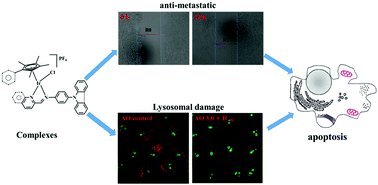当前位置:
X-MOL 学术
›
Inorg. Chem. Front.
›
论文详情
Our official English website, www.x-mol.net, welcomes your
feedback! (Note: you will need to create a separate account there.)
Lysosome-targeted iridium(iii) compounds with pyridine-triphenylamine Schiff base ligands: syntheses, antitumor applications and mechanisms†
Inorganic Chemistry Frontiers ( IF 6.1 ) Pub Date : 2019-10-15 , DOI: 10.1039/c9qi01161g Shujiao Chen 1, 2, 3, 4, 5 , Xicheng Liu 1, 2, 3, 4, 5 , Xingxing Ge 1, 2, 3, 4, 5 , Qinghui Wang 1, 2, 3, 4, 5 , Yaoqi Xie 1, 2, 3, 4, 5 , Yingying Hao 1, 2, 3, 4, 5 , Ying Zhang 1, 2, 3, 4, 5 , Lei Zhang 1, 2, 3, 4, 5 , Wenjing Shang 1, 2, 3, 4, 5 , Zhe Liu 1, 2, 3, 4, 5
Inorganic Chemistry Frontiers ( IF 6.1 ) Pub Date : 2019-10-15 , DOI: 10.1039/c9qi01161g Shujiao Chen 1, 2, 3, 4, 5 , Xicheng Liu 1, 2, 3, 4, 5 , Xingxing Ge 1, 2, 3, 4, 5 , Qinghui Wang 1, 2, 3, 4, 5 , Yaoqi Xie 1, 2, 3, 4, 5 , Yingying Hao 1, 2, 3, 4, 5 , Ying Zhang 1, 2, 3, 4, 5 , Lei Zhang 1, 2, 3, 4, 5 , Wenjing Shang 1, 2, 3, 4, 5 , Zhe Liu 1, 2, 3, 4, 5
Affiliation

|
Six N-phenylcarbazole/triphenylamine modified half-sandwiched iridium(III) Schiff base compounds ([(η5-Cpx)Ir(N^N)Cl]PF6) were synthesised and characterised in this study. The regulation and introduction of Schiff bases increased the antitumor activity of these compounds (IC50: 1.4 ± 0.1 μM–11.5 ± 0.5 μM). The highest antitumor activity exhibited by these compounds was nearly 13 times that of clinical cisplatin. Interestingly, these compounds could also effectively block the migration of cancer cells. These compounds were observed to bind to proteins (binding constant: ∼104 M−1) and transport through serum protein, catalyse the oxidation of the coenzyme nicotinamide-adenine dinucleotide, and increase reactive oxygen species levels in cells, which resulted in an antitumor mechanism of oxidation. Laser confocal microscopy and flow cytometry studies confirmed that these compounds possessed an energy-dependent cellular uptake mechanism, effectively accumulated in lysosomes (Pearson co-localization coefficient: ∼0.75), damaged the integrity of acidic lysosomes, disrupted the cell cycle, induced a change in mitochondrial membrane potential, and eventually led to apoptosis. All these findings suggest that these compounds are potential antitumor agents with dual functions: metastasis inhibition and lysosomal damage.
中文翻译:

吡啶-三苯胺席夫碱配体 靶向溶酶体的铱(iii)化合物:合成,抗肿瘤应用和作用机制†
六Ñ -phenylcarbazole /三苯胺改性半夹铱(III)的席夫碱的化合物([(η 5 -Cp X)IR(N ^ N)CL] PF 6)的合成和表征在本研究中。Schiff碱的调节和引入增加了这些化合物的抗肿瘤活性(IC 50:1.4±0.1 μM–11.5±0.5μM)。这些化合物表现出的最高抗肿瘤活性是临床顺铂的近13倍。有趣的是,这些化合物也可以有效地阻止癌细胞的迁移。观察到这些化合物与蛋白质结合(结合常数:〜10 4 M -1)并通过血清蛋白运输,催化辅酶烟酰胺-腺嘌呤二核苷酸的氧化,并增加细胞中的活性氧水平,从而导致抗肿瘤的氧化机制。激光共聚焦显微镜和流式细胞术研究证实,这些化合物具有能量依赖的细胞摄取机制,有效地积累在溶酶体中(Pearson共定位系数:〜0.75),破坏了酸性溶酶体的完整性,破坏了细胞周期,引起了变化在线粒体膜上存在电位,并最终导致细胞凋亡。所有这些发现表明,这些化合物是具有双重功能的潜在抗肿瘤药:转移抑制和溶酶体损伤。
更新日期:2019-12-18
中文翻译:

吡啶-三苯胺席夫碱配体 靶向溶酶体的铱(iii)化合物:合成,抗肿瘤应用和作用机制†
六Ñ -phenylcarbazole /三苯胺改性半夹铱(III)的席夫碱的化合物([(η 5 -Cp X)IR(N ^ N)CL] PF 6)的合成和表征在本研究中。Schiff碱的调节和引入增加了这些化合物的抗肿瘤活性(IC 50:1.4±0.1 μM–11.5±0.5μM)。这些化合物表现出的最高抗肿瘤活性是临床顺铂的近13倍。有趣的是,这些化合物也可以有效地阻止癌细胞的迁移。观察到这些化合物与蛋白质结合(结合常数:〜10 4 M -1)并通过血清蛋白运输,催化辅酶烟酰胺-腺嘌呤二核苷酸的氧化,并增加细胞中的活性氧水平,从而导致抗肿瘤的氧化机制。激光共聚焦显微镜和流式细胞术研究证实,这些化合物具有能量依赖的细胞摄取机制,有效地积累在溶酶体中(Pearson共定位系数:〜0.75),破坏了酸性溶酶体的完整性,破坏了细胞周期,引起了变化在线粒体膜上存在电位,并最终导致细胞凋亡。所有这些发现表明,这些化合物是具有双重功能的潜在抗肿瘤药:转移抑制和溶酶体损伤。











































 京公网安备 11010802027423号
京公网安备 11010802027423号